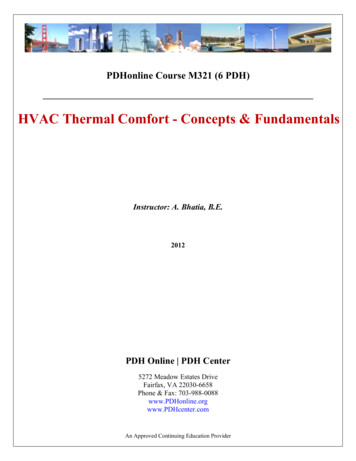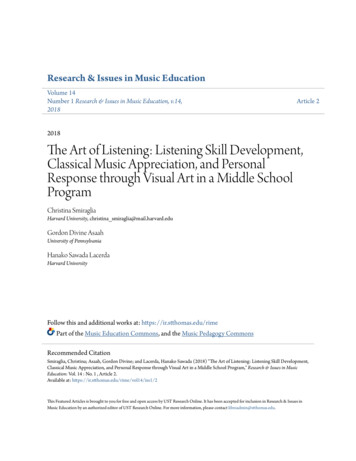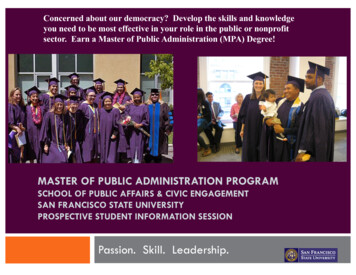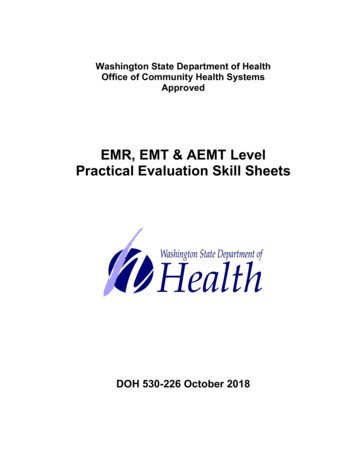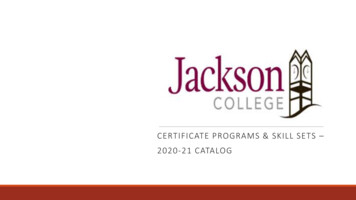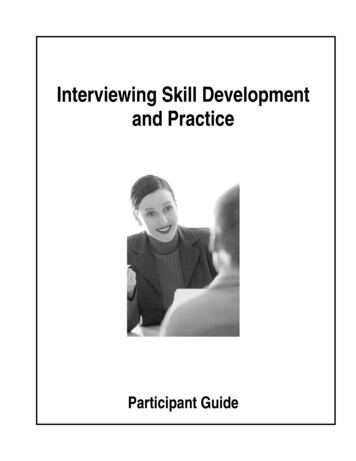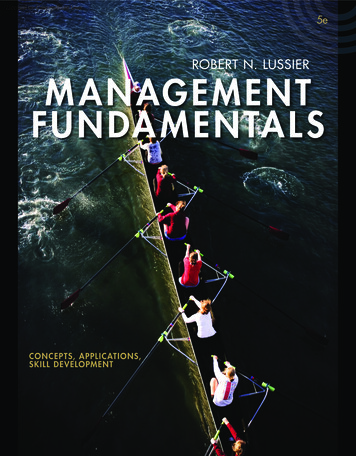
Transcription
Licensed to: CengageBrain User
Licensed to: CengageBrain UserThis is an electronic version of the print textbook. Due to electronic rights restrictions,some third party content may be suppressed. Editorial review has deemed that any suppressedcontent does not materially affect the overall learning experience. The publisher reserves the rightto remove content from this title at any time if subsequent rights restrictions require it. Forvaluable information on pricing, previous editions, changes to current editions, and alternateformats, please visit www.cengage.com/highered to search by ISBN#, author, title, or keyword formaterials in your areas of interest.Copyright 2011 Cengage Learning. All Rights Reserved. May not be copied, scanned, or duplicated, in whole or in part. Due to electronic rights, some third party content may be suppressed from the eBook and/or eChapter(s).Editorial review has deemed that any suppressed content does not materially affect the overall learning experience. Cengage Learning reserves the right to remove additional content at any time if subsequent rights restrictions require it.
Licensed to: CengageBrain UserManagement Fundamentals: Concepts,Applications, Skill Development, Fifth EditionRobert N. LussierVice President/Editorial Director:Jack W. CalhounPublisher: Erin JoynerExecutive Editor: Scott Person 2012, 2009 South-Western, Cengage LearningALL RIGHTS RESERVED. No part of this work covered by the copyright hereinmay be reproduced, transmitted, stored or used in any form or by any meansgraphic, electronic, or mechanical, including but not limited to photocopying,recording, scanning, digitizing, taping, Web distribution, information networks,or information storage and retrieval systems, except as permitted under Section 107 or 108 of the 1976 United States Copyright Act, without the prior written permission of the publisher.Developmental Editor: Leslie Kauffman, LEAP, Inc.Senior Editorial Assistant: Ruth BelangerFor product information and technology assistance, contact us atCengage Learning Customer & Sales Support, 1-800-354-9706Marketing Manager: Jon MonahanMarketing Coordinator: Julia TuckerContent Project Management: PreMediaGlobalMedia Editor: Rob EllingtonFor permission to use material from this text or product,submit all requests online at www.cengage.com/permissionsFurther permissions questions can be emailed topermissionrequest@cengage.comManufacturing Buyer: Arethea ThomasSenior Marketing Communications Manager:Jim OverlyProduction Service: PreMediaGlobalExamView is a registered trademark of eInstruction Corp. Windows is aregistered trademark of the Microsoft Corporation used herein under license.Macintosh and Power Macintosh are registered trademarks of AppleComputer, Inc. used herein under license.Senior Art Director: Tippy McintoshCover Designer: Mike Stratton, Stratton Design 2008 Cengage Learning. All Rights Reserved.Cover Image: Shelly Perry, iStockphotoCengage Learning WebTutor is a trademark of Cengage Learning.Rights Acquisitions Specialist: John HillLibrary of Congress Control Number: 2011926624ISBN-13: 978-1-111-57752-0ISBN-10: 1-111-57752-8South-Western5191 Natorp BoulevardMason, OH 45040USACengage Learning products are represented in Canada by NelsonEducation, Ltd.For your course and learning solutions, visit www.cengage.com/schoolVisit our company website at www.cengage.comPrinted in the United States of America1 2 3 4 5 6 7 15 14 13 12 11Copyright 2011 Cengage Learning. All Rights Reserved. May not be copied, scanned, or duplicated, in whole or in part. Due to electronic rights, some third party content may be suppressed from the eBook and/or eChapter(s).Editorial review has deemed that any suppressed content does not materially affect the overall learning experience. Cengage Learning reserves the right to remove additional content at any time if subsequent rights restrictions require it.
Licensed to: CengageBrain User1MANAGEMENT ANDENTREPRENEURSHIPLearning OutcomesAfter studying this chapter, you should be able to:1. Describe a manager’s responsibility. PAGE 42. List and explain the three management skills. PAGE 83. List and explain the four management functions. PAGE 114. Identify the three management role categories. PAGE 125. List the hierarchy of management levels. PAGE 146. Describe the three different types of managers. PAGE 167. Describe the differences among management levels in terms of skills needed andfunctions performed. PAGE 178. Explain the difference between an entrepreneur and an intrapreneur. PAGE 21managermanager’s resourcesperformancemanagement skillstechnical skillsinterpersonal skillsdecision-making skillsmanagement ement rolecategorieslevels of managementtypes of managersknowledge managementnew ventureentrepreneursintrapreneurssmall businesscompetitive advantagefirst-mover advantagebusiness planCopyright 2011 Cengage Learning. All Rights Reserved. May not be copied, scanned, or duplicated, in whole or in part. Due to electronic rights, some third party content may be suppressed from the eBook and/or eChapter(s).Editorial review has deemed that any suppressed content does not materially affect the overall learning experience. Cengage Learning reserves the right to remove additional content at any time if subsequent rights restrictions require it. British Retail Photography / Alamy9. Define the following key terms:
Licensed to: CengageBrain UserIDEAS ON MANAGEMENTat Gap Inc.Gap Inc. is one of the world’s largest specialty retailers, offeringclothing, accessories, and personal care products for men, women,children, and babies under the Gap, Banana Republic, Old Navy,Piperlime, and Athleta brand names. Gap brand includes Gap,GapKids, babyGap, and GapBody. The company also operatesGap Outlet and Banana Republic Factory Outlet stores. Gap Inc.has stores in the United States, Canada, United Kingdom, France,Ireland, and Japan.Gap Inc. has a customer-driven culture and reputation. In otherwords, all Gap Inc. employees view focusing on the customer asthe most important part of their jobs. Evidence of this dedicationis Gap Inc.’s policy of greeting each customer at the door to makehim or her feel welcome and to determine how the staff can help.All store managers work the floor and are evaluated and promotedaccording to how well they deal with customers. Gap Inc. has apromotion policy that enables talented, hardworking managers tomove ahead, but the competition for advancement is no cakewalk.Those who are willing to relocate can climb the corporate laddermore rapidly.1.2.3.4.What resources does Gap Inc. use to sell its merchandise?What management functions are performed at Gap stores?What levels and types of managers have careers at Gap Inc.?Is Gap Inc. entrepreneurial and/or intrapreneurial?You’ll find answers to these questions about management at Gap Inc.throughout the chapter, and you will also learn about Gap managerBonnie Castonguary and her experiences in managing several storesfor this casual-look retailer.Source: Information for the case was taken from Gap’s Web site at http://www.gapinc.com,accessed January 21, 2011.CHAPTER OUTLINEWhy Study Management?What Is a Manager’sResponsibility?Organizational ResourcesWhat Does It Take to Be aSuccessful Manager?Management QualitiesManagement SkillsAACSB CompetenciesSupervisory AbilityWhat Do Managers Do?Management FunctionsNonmanagement FunctionsManagement RolesThe Systems Relationship amongthe Management Skills, Functions,and RolesDifferences among ManagersThe Three Levels of ManagementTypes of ManagersDifferences in Management SkillsDifferences in ManagementFunctionsLarge-Business versus SmallBusiness ManagersManagers of For-Profit versusNot-for-Profit OrganizationsManaging the Old versusNew WorkplaceEntrepreneurshipWHY STUDY MANAGEMENT?It’s natural at this point to be thinking, “What can I get from thisbook?” or “What’s in it for me?” These common questions are seldom asked or answered directly. The short answer is that the betteryou can work with people—and this is what most of this book isabout—the more successful you will be in both your personal andyour professional lives.1 If you are a manager, or want to be a manager someday, the need for good management skills is self-evident.2Even if you are not interested in being a manager, you still need management skills to succeed in today’s workplace.3 The old workplace,in which managers simply told employees what to do, is gone. Today,employees want to be involved in management,4 and organizationsexpect employees to work in teams and share in decision making andother management tasks.5New Venture Entrepreneursand IntrapreneursContributions of EntrepreneursSelecting the New VentureThe Business PlanSources of Assistance in Planning,Starting, and Managing the NewVentureObjectives of the BookManagement ConceptsApplication of ManagementConceptsDevelopment of ManagementSkillsFlexibilityOrganization of the BookCopyright 2011 Cengage Learning. All Rights Reserved. May not be copied, scanned, or duplicated, in whole or in part. Due to electronic rights, some third party content may be suppressed from the eBook and/or eChapter(s).Editorial review has deemed that any suppressed content does not materially affect the overall learning experience. Cengage Learning reserves the right to remove additional content at any time if subsequent rights restrictions require it.
Licensed to: CengageBrain User4Part 1 The Global Management EnvironmentThe study of management also applies directly to your personal life. You communicate with and interact with people every day; you make personal plans anddecisions, set goals, prioritize what you will do, and get others to do things for you.Are you ever in conflict with family and friends, and do you ever feel stressed? Thisbook can help you develop management skills that you can apply in all of thoseareas. In this chapter, you will learn what management is all about, and we willbegin the discussion of how you can develop your management skills.CSQ-1CSQ-2WHAT IS A MANAGER’S RESPONSIBILITY?This interview with Bonnie Castonguary, a store manager for Gap Inc., provides anoverview of the manager’s job and responsibility.Q: What was your progression to your present job as store manager?A: I started as a store manager in training. I replaced a woman on maternity leaveas acting store manager, and then I had my first store. After a while, I was promoted to larger stores with more sales volume. A few years later, I was promoted to manager of [a] Gap outlet store. . . . My next career advancement is togeneral manager . . . I would still be in one store, but I would assist the districtmanager by overseeing other stores in my district.Q: Briefly describe your job.A: Gap Inc.’s two-page “Position Overview Store Management” form, which alsocontains a detailed summary for each level of management, presents this generalsummary: “The Store Management team manages the sales, operations, and personnel functions of the store to ensure maximum profitability and compliancewith company procedures. The Team includes Assistant Managers, AssociateManagers, the Store Manager, and/or the General Manager.” [See Exhibit 1-1for Castonguary’s description of a typical Monday.]Q: What do you like best about being a manager?A: You don’t have time to get bored on the job because you are always doing something different.Q: What do you like least about being a manager?A: Dealing with difficult performance problems of employees and customers, and alwaysbeing on call. When I’m not at work, I’m still on call when there are problems at thestore. This could mean going to the store at 2:00 a.m. to shut off the alarm.Q: What advice would you give to college graduates without any full-time workexperience who are interested in a management career after graduation?A: You need to be dedicated and hardworking. You must take great pride in yourwork. You have to be willing to take on a lot of responsibility. Remember, youremployees are always looking to you to set the example; when you make a mistake (which you will do), it affects your staff. You have to be a self-starter. Asa store manager you have to motivate employees, but your boss is not aroundmuch to motivate you.LEARNING OUTCOME 1Describe a manager’s responsibility.managerThe individual responsiblefor achieving organizationalobjectives through efficientand effective utilization ofresources.manager’s resourcesHuman, financial, physical,and informational resources.ORGANIZATIONAL RESOURCESA manager is responsible for achieving organizational objectives through efficientand effective utilization of resources. Efficient means doing things right so as tomaximize the utilization of resources. Effective means doing the right thing in orderto attain an objective; a manager’s effectiveness reflects the degree to which he orshe achieves objectives.6 The manager’s resources are human, financial, physical,and informational.Copyright 2011 Cengage Learning. All Rights Reserved. May not be copied, scanned, or duplicated, in whole or in part. Due to electronic rights, some third party content may be suppressed from the eBook and/or eChapter(s).Editorial review has deemed that any suppressed content does not materially affect the overall learning experience. Cengage Learning reserves the right to remove additional content at any time if subsequent rights restrictions require it.
Licensed to: CengageBrain UserChapter 1 Management and EntrepreneurshipExhibit 1-1 A Day in the Life of a Manager8:00 A.M. Enter the store and walk the sales floor to ensure a proper closing took place thenight before. Project the payroll cost for the week as a percentage of my forecasted sales, andcall it in. Perform opening procedures on the controller (computer that records sales transactions and inventory count for all cash registers in the store).8:30 A.M. Walk the sales floor with staff and assign projects for them to create new displaysfor merchandise during the day (create a “to do” list for employees and myself).9:00 A.M. Before the store opens, call voice mail and check e-mail for messages left by otherstore managers or my boss, the district manager. Make business telephone calls for the day.9:30 A.M. Assign sales associates to store zones. Put money in computer cash register drawers.10:00 A.M. Open the store.Make sure sales associates are in their zones on the floor for proper floor coverage.Make sure everyone who enters the store is greeted and has his or her needs determined.Provide floor coverage. (Help out as needed—greet customers, assist customerswith sales, stock shelves, assist at the changing room, etc.)12:00 P.M. Do business analysis for previous month from operating statement and grossmargin reports.12:30 P.M. Provide floor coverage as needed for staggered employee breaks.1:30–2:30 P.M. My break, then: Prepare customer request transfers (merchandise our store has but other stores donot have) to be delivered. Enter transfers into computer and get merchandise.3:00 P.M. Leave for district meeting.3:15 P.M. Drop off transfers and pick up another store manager; continue on to district meeting.4:00 P.M. Meeting is conducted by district manager with the seven general and store managers.Meeting begins with discussion of the following topics:Previous week’s sales, previous week’s payroll, payroll projections for next month(cost as a percentage of sales), cleanliness, and standards of the stores.New information items, mail, general discussion, questions, etc. Meeting ends with a walk-through of the store at which the meeting is held. Duringa walk-through, the host store manager discusses new display ideas that the otherstore managers may want to use. In addition, the other store managers give thehost manager ideas for improving the store visually. In other words, this is a time toshare ideas that will help all team members in the Gap district.6:00 P.M. Call my store to see how sales are going for the day, then leave for home.Copyright 2011 Cengage Learning. All Rights Reserved. May not be copied, scanned, or duplicated, in whole or in part. Due to electronic rights, some third party content may be suppressed from the eBook and/or eChapter(s).Editorial review has deemed that any suppressed content does not materially affect the overall learning experience. Cengage Learning reserves the right to remove additional content at any time if subsequent rights restrictions require it.5
Licensed to: CengageBrain User6Part 1 The Global Management EnvironmentHuman ResourcesHuman resources are people. Managers are responsible for getting the job donethrough employees.7 People are the manager’s most valuable resource;8 treat themwell and they will take care of your customers.9 Throughout this book, we will focuson how managers work with employees to accomplish organizational objectives.CSQ-3CSQ-4Financial ResourcesIt takes money to make money, and without proper finances you don’t have a business.10 Most managers have a budget stating how much it should cost to operatetheir department/store for a set period of time. In other words, a budget defines thefinancial resources available.Physical ResourcesGetting the job done requires effective and efficient use of physical resources throughcontrol mechanisms.11 Managers are responsible for keeping equipment in workingcondition and for making sure that necessary materials and supplies are available.Deadlines might be missed and present sales and future business lost if physical resources are not available and used and maintained properly.12Informational ResourcesperformanceMeans of evaluating howeffectively and efficientlymanagers utilize resourcesto achieve objectives.Information continues to increase in importance as a means of increasing the speedof doing business in a competitive global environment.13 Managers need information in order to share knowledge throughout the organization,14 which in turn enables them to make good decisions.Managers have a profound impact on the performance of their organizations.15The level of organizational performance is based on how effectively and efficientlymanagers utilize resources to achieve objectives. Managers are responsible for andevaluated on how well they meet organizational objectives through utilization of resources.16 Selecting the right resources—being effective—and using them efficientlyresults in high levels of performance.17 During the recent economic recession, managers focused on efficiency by cutting costs.18 This was often accomplished by laying off employees and having the remaining workers produce the same results, ormore, with fewer resources on hand.RQ-1workapplication11Describe the specific resourcesused by a present or pastboss. Give the manager’s jobtitle and department.Gap Inc. has more than 135,000 human resources to help in the sale of its merchandise. In order to acquire financial resources to expand, Gap Inc. sold stockand took out loans. Castonguary has a budget for her store, as do managersat all Gap stores, and she is responsible for sales revenues gained when customers use cash and credit cards. Physical resources of Gap Inc. include morethan 3,000 stores, and each store has fixtures to display its merchandise. GapInc.’s major information system is its controller (a computer system), which storesinformation from all Gap stores that can be retrieved by Gap managers. WhenCastonguary was checking her voice mail and e-mail, making calls, giving employees directions on setting up displays, attending the district meeting, andparticipating in the store walk-through, she was using informational resources.Gap Inc.’s growth from one store to more than 3,000 represents a high level ofperformance.WHAT DOES IT TAKE TO BE A SUCCESSFULMANAGER?Now that you have an idea of what management is, let’s focus on some of the qualities, skills, and competencies necessary to be a successful manager.Copyright 2011 Cengage Learning. All Rights Reserved. May not be copied, scanned, or duplicated, in whole or in part. Due to electronic rights, some third party content may be suppressed from the eBook and/or eChapter(s).Editorial review has deemed that any suppressed content does not materially affect the overall learning experience. Cengage Learning reserves the right to remove additional content at any time if subsequent rights restrictions require it.
Licensed to: CengageBrain UserChapter 1 Management and Entrepreneurship7MANAGEMENT QUALITIESOver the years, numerous researchers have attempted to answer the question “Whatdoes it take to be a successful manager?” In a Wall Street Journal Gallup survey, 782top executives in 282 large corporations were asked, “What are the most importanttraits for success as a supervisor?”19 Before you read what these executives replied,complete the Self-Assessment on management traits to find out if you have what ittakes to become a successful manager.The executives in the Gallup survey identified integrity, industriousness, and theability to get along with people as the three most important traits for successfulmanagers. Other necessary traits included business knowledge, intelligence, leadership ability, education, sound judgment, ability to communicate, flexibility, andability to plan and set objectives. Management is about understanding people20 anddeveloping good relationships to get the job done.21workapplication2Identify a specific manager,preferably one who is or wasyour boss, and explain whatmakes him or her successful orunsuccessful. Give examples.LEARNING OUTCOME 2List and explain the three management skills.MANAGEMENT TRAITSThe following 15 questions relate to some of thequalities needed to be a successful manager. Rateyourself on each item by indicating with a number(1–4) how well each statement describes you.4. The statement does not describe me at all.3. The statement somewhat describes me.2. The statement describes me most of the time.1. The statement describes me very accurately1. I enjoy working with people. I prefer towork with others rather than workingalone.2. I can motivate others. I can get people todo things they may not want to do.3. I am well liked. People enjoy workingwith me.4. I am cooperative. I strive to help the teamdo well, rather than to be the star.5. I am a leader. I enjoy teaching, coaching, and instructing people.6. I want to be successful. I do things to thebest of my ability to be successful.7. I am a self-starter. I get things donewithout having to be told to do them.8. I am a problem-solver. If things aren’tgoing the way I want them to, I takecorrective action to meet my objectives.9. I am self-reliant. I don’t need the help ofothers.10. I am hardworking. I enjoy working andgetting the job done.11. I am trustworthy. If I say I will do something by a set time, I do it.12. I am loyal. I do not do or say things tointentionally hurt my friends, relatives, orcoworkers.13. I can take criticism. If people tell menegative things about myself, I givethem serious thought and change whenappropriate.14. I am honest. I do not lie, steal, or cheat.15. I am fair. I treat people equally. I don’ttake advantage of others.Total score (add numbers on lines 1–15; therange of possible scores is 15–60)In general, the lower your score, the better yourchances of being a successful manager. You canwork on improving your integrity (items 11–15),industriousness (items 6–10), and ability to getalong with people (items 1–5) both in this courseand in your personal life. As a start, review thetraits listed here. Which are your strongest andweakest ones? Think about how you can improvein the weaker areas, or even better, write outa plan.Copyright 2011 Cengage Learning. All Rights Reserved. May not be copied, scanned, or duplicated, in whole or in part. Due to electronic rights, some third party content may be suppressed from the eBook and/or eChapter(s).Editorial review has deemed that any suppressed content does not materially affect the overall learning experience. Cengage Learning reserves the right to remove additional content at any time if subsequent rights restrictions require it.
Licensed to: CengageBrain User8Part 1 The Global Management EnvironmentMANAGEMENT SKILLSmanagement skillsThe skills needed to be aneffective manager, includingtechnical, interpersonal, anddecision-making skills.All employees today need good management skills.22 Because management skills areso important, the focus of this book is on skill building. If you work at it, you candevelop your management skills through this course.For our purposes, management skills include (1) technical, (2) interpersonal, and(3) decision-making skills. You should work to develop these three kinds of skills tobe an effective administrator.23Technical Skillstechnical skillsThe ability to use methods andtechniques to perform a task.Technical skills involve the ability to use methods and techniques to performa task. Technical skills are also called business skills, and they are the easiestof the three management skills to develop. 24 When managers are working onbudgets, for example, they may need computer skills in order to use spreadsheetsoftware such as Microsoft Excel . Most employees are promoted to their firstmanagement position primarily because of their technical skills. Technical skillsvary widely from job to job; therefore, this course does not focus on developing these skills. However, to be successful, keep up with the latest technology inyour field.25Interpersonal Skillsinterpersonal skillsThe ability to understand,communicate, and work wellwith individuals and groupsthrough developing effectiverelationships.Interpersonal skills involve the ability to understand, communicate, and work wellwith individuals and groups through developing effective relationships. Interpersonal skills are sometimes also referred to as human or people skills, as well assoft skills. The resources you need to get the job done are made available throughrelationships, both inside (employees) and outside (customers, suppliers, others) thefirm.26 Organizations are seeking employees with good interpersonal skills,27 andbusiness schools are placing more emphasis on people skills.28 Interpersonal skillsare based on several other skills, including: Communication skills. Effective relationships are based on good, open, and honest communications.29 You will learn how to develop your communication skillsin Chapter 10. Team skills. Teams are the backbone of organizations, so employers are seekingemployees with team skills.30 You will learn how to develop your team skills inChapter 12. Diversity skills. In the global economy, you need to be able to develop good working relationships with “all” people regardless of how they differ from you.31 Youwill learn more about diversity in Chapter 6. Power, political, negotiation, and networking skills. Successful people accomplishtheir personal and professional goals through their power, political influence,and networking relationships with others.32 You will learn how to develop yourpower, political, and negotiation skills in Chapter 8 and your networking skills inAppendix C. Motivation skills. In order to get people to help you and to get them to do theirbest, you have to be able to motivate them through good relationships.33 Youwill learn about your own motivation and learn how to develop your motivationskills in Chapter 11. Conflict management skills. In any relationship, we encounter conflict. Therefore,to develop and maintain effective relationships, you need to be able to resolveconflicts without hurting the relationship.34 You will learn how to deal with conflict in Chapter 8. Ethics skills. In order to have good relationships, you have to treat people rightby being ethical.35 You will learn more about ethics and how to make ethicaldecisions in Chapter 2.Copyright 2011 Cengage Learning. All Rights Reserved. May not be copied, scanned, or duplicated, in whole or in part. Due to electronic rights, some third party content may be suppressed from the eBook and/or eChapter(s).Editorial review has deemed that any suppressed content does not materially affect the overall learning experience. Cengage Learning reserves the right to remove additional content at any time if subsequent rights restrictions require it.
Licensed to: CengageBrain UserChapter 1 Management and Entrepreneurship9DECISION-MAKING SKILLSClearly, the decisions you have made over your lifetime have affected you today. Leadership decisions determine the success or failure of organizations,36 so organizationsare training their people to improve their decision-making skills.37 Decision-makingskills are based on the ability to conceptualize situations and select alternatives to solveproblems and take advantage of opportunities. Decision-making skills are based onseveral other skills, including: Conceptual skills. Managers need to understand abstract ideas as well as the interrelationship of the parts of a business and their relationship to the firm as awhole; they need to use a systems-based analysis in decision making.38 You willlearn more about conceptual skills in Chapter 3. Diagnostic, analytical, and critical-thinking skills. These skills are about understanding the nature or cause of a problem or opportunity through experienceand research. Managers need the ability to understand a situation and make themost appropriate decision.39 You will learn more about diagnostic, analytical,and critical-thinking skills in Chapter 3. Quantitative reasoning skills. Today’s successful managers use math to help quantify alternative courses of action in decision making in order to select the mostappropriate course of action to maximize resources. You will learn about quantitative methods commonly used in decision making in Chapter 3. Time management skills. Time management is about bei
A: Gap Inc.’s two-page “Position Overview Store Management” form, which also contains a detailed summary for each level of management, presents this general summary: “The Store Management team manages the sales, operations, and per-sonnel functions of the store to ensure maxim

